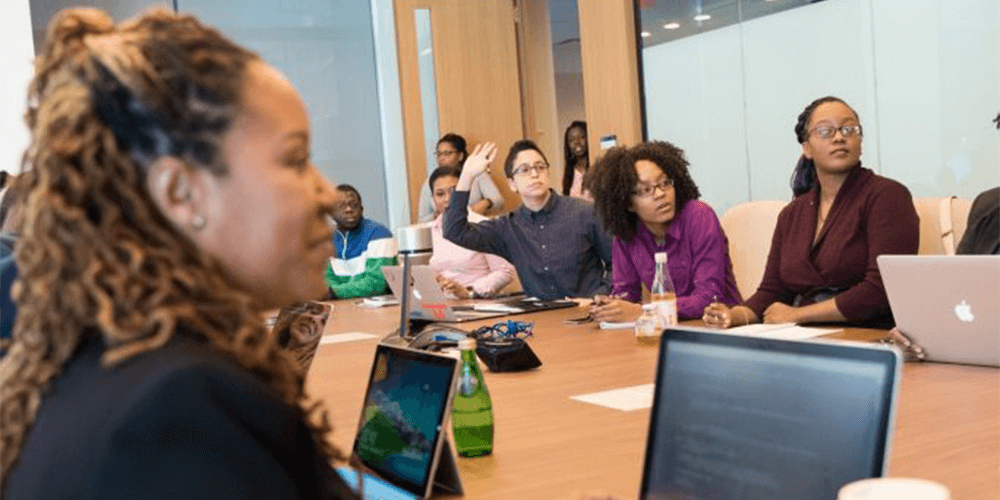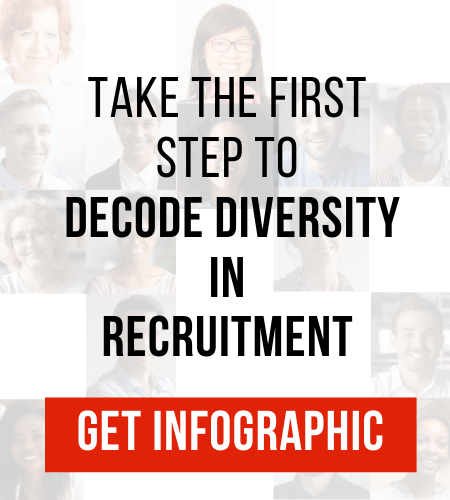- Solutions
- Products
- Community
- Resources
- Company


Right now, employers everywhere are emphasizing the importance of diversity and inclusion in recruiting. We’re all hungry for practical ways to find, hire, and retain diverse talent. To us, that means attracting and welcoming people from a variety of backgrounds, views, and experiences.
Building a vibrant, high-performing workforce takes guts – it means purposely seeking out people who may not always agree. It means challenging one another to do and think differently. It means finding people who may not look alike or share similar experiences.
We want to be open and welcoming, and not only because it’s the right thing to do. Diverse workforces are winning workforces, leading to more innovation and revenue than less diverse peers. Like a puzzle, your workforce is a collection of the right people placed in exactly the right role. Individually unique, they are far more than the sum of their parts.
Here’s a collection of some of our favorite stories, strategies, and tactics for building a diverse and inclusive workforce. Read through to the end for our downloadable infographic, Decode diversity: How to recruit high-performing teams.
Contents:
Building a culture of diversity and inclusion in recruitment
Sourcing diverse skills, experiences, and voices
Hiring and promoting women in the workforce
Using recruiting software to build diverse workforces


The last year has been personally and professionally life-altering for most people. We’ve experienced shifts in how we think about connecting with others, how we communicate, and how we work.
Many businesses are still adjusting priorities and practices to thrive in the virtual and hybrid workplace. An essential part of this business evolution includes redefining our values and corporate culture to match our new realities.
In this article we discuss:
Read on to learn how to foster a workplace culture that embodies and represents your values.
We don’t just celebrate the black community because the calendar hit February 1st. We celebrate, support, and highlight black employees and other Historically Excluded Groups (HEGs) throughout the year.
It’s important our employees know they truly belong here. By living our values, we attract, engage, hire, and advance a winning workforce – and empower other organizations to do the same.
In this article our team shares:
Read on to learn how our employees celebrate diversity and promote inclusivity all year round.
We had the pleasure of chatting with Cynthia Marshall – or Cynt as she prefers to be called – as she joined us for a dynamic keynote at our INSPIRE virtual global conference. Cynt’s story is what keeps us inspired to continue to work to make inclusion a standard for workplaces around the world.
Cynt spent nearly 36 years – 13,088 days to be exact – with AT&T, where she served as the SVP of Human Resources and Chief Diversity Officer. Now, she is at the helm of the Dallas Mavericks, serving as the first black, female CEO in the NBA.
In this article you’ll see some of Cynt’s best advice, including:
Read on to learn about Cynt’s amazing career and how you can apply her value-based playbook.
The pressure is on. With everything going on in the world today, particularly in large cities, companies are on the line to say something; do something; change.
That’s why corporate diversity and inclusion initiatives are popping up at your organization (hopefully), in your social feeds, and topping your inboxes.
In this article, we look at how to start a diversity and inclusion initiative, starting with:
Read on for areas to focus on and ways to track success.
We sat down with Chantell Cooper, Director of Talent Acquisition at Arbonne International, a leader in the beauty and wellness industry. It’s an industry that’s been hard-hit by global lockdowns.
But that doesn’t mean Chantell has time to rest on her laurels. Chantell’s job is to sell Arbonne’s employer brand, not its products – and that’s a job that doesn’t take breaks.
In this article, Chantell discusses how to make your brand stand out from the competition and improve your diversity and inclusion efforts by:
Read on to see Cooper’s advice for differentiating your employer brand in challenging times.
In 2018 the Mavs hit a low–and not in their basketball rankings. They found themselves in a media frenzy for what was happening in the corporate office. Fast forward to 2020 and they have set the NBA standard for diversity and inclusion.
How’d they do it? Mark Cuban, Dallas Mavericks owner, recruited diversity and inclusion expert Cynthia Marshall to “save” their culture and ultimately their brand.
In this article, we’ll take a look at:
Read on to learn how Marshall created a 100-day plan to turn the Mavericks around.


The new future of work is here. Moving forward, job seekers’ expectations will be less about performance and compensation and more about a flexible work-life balance, benefits, and an empathetic culture.
As you pull candidates in through recruitment marketing to assess their skills, they’re also actively assessing you. Are you the employer that’s the best fit for their goals?
In this article we explore ways to:
Read on to discover how to build an inclusive hiring program.
Serving active duty military and veterans has always been core to Enterprise Rent-A-Car’s DNA. In fact, Enterprise has branches on more than 70 U.S. military bases worldwide.
While most companies weren’t named after aircraft carriers or founded by navy pilots, they do understand the value military veterans bring to the private sector.
In this article we explore ways to attract and hire military veterans by:
Read on for our tips to making your company more attractive to veteran hires.
Despite huge advances in recruiting technology, our recruiting processes are slowing down. In fact, time to hire has increased by 30% in 5 years. Most of the time, line managers still rely on gut instinct to make hiring decisions. Why is this happening?
In this article we discuss:
Read on to see how to shape your priorities to hire candidates faster.
As furloughs and layoffs continue, more Americans find themselves looking for work outside their industry. For the recruiter, the influx of candidates complicates the sourcing process – a wider, more diverse set of candidates requires thoughtfulness.
To help recruiters manage applicants with mixed skills and experience, we interviewed the Director and Associate Manager of Talent Acquisition at iCIMS. Together, they have 33 years of experience in TA and have seen the market flux in every direction.
In this article, we explore ways to:
Read on to see their advice to today’s recruiters.
We are more aware of how our behaviors impact our work environment. But is there a risk of diversity and inclusion being buzzwords that leaders put out there to remain relevant? What role should employers play in creating a diverse, inclusive environment?
In this article, we share ways to:
Read on for ways to build a sustainable D&I program within your organization.


If a man and a woman apply to the same job, the woman is 16% more likely to be hired. Yet women make up just 26% of all tech applicants – and 25% of all tech hires. We won’t come anywhere near close to hiring parity until men and women are applying in roughly equal numbers.
In this article we discuss ways to attract and advance more women by:
Read on for five simple ways to ignite positive change in your workplace.
Six years ago, Andreea Wade tweeted that she wanted to go on a hike. Three hours later, that tweet turned into an idea and into a branded event with 40 signups.
The group, StartUp Hiking, is a small line item on the list of Andreea’s many accomplishments – all of them greatly different from the next. The common thread in all those projects is Andreea’s hunger for solving problems.
In this article we share Andreea Wade’s story, including:
Read on to learn how Andreea Wade went from frustrated candidate to startup success.


Everyone wants to say that their tech enables them to eliminate bias and build a diverse, winning workforce. Unfortunately, that’s just not the case. Legacy applicant tracking systems are not built to source and hire diverse candidates.
What’s the answer? You use an applicant tracking system that’s continually learning.
In this article we explore ways your applicant tracking system can:
Read on to learn how to pick the right applicant tracking system to support DEI.
Bias starts in the hiring process. Teams will always have some level of bias in the way they attract and engage talent. It’s human nature. But it doesn’t end at the perspectives of your people. If the way you hire today looks like it did a decade ago, there is likely bias inherent in your process.
In this article, we discuss ways AI recruiting software can help you:
Read on to see how AI recruiting software can help you achieve greater workplace diversity.
For those still hiring during the pandemic, cancelling recruiting events may seem like your only choice. It’s not. In fact, pivoting to virtual career fairs creates the same level of interaction and engagement as an in-person event.
In this article we explore how virtual career fair platforms can:
Read on for ways to get the most out of online recruiting events.
When the subconscious is involved, so is bias—it’s only natural. That’s why the selection process and supporting your applicant tracking system are key for diversity.
Not only is unbiased hiring our path to a more inclusive future of work, it’s the best way organizations can eliminate risk of overlooking their best-fit candidates.
In this article we share ways to reduce bias by:
Read on for actionable tips on identifying and reducing hiring bias with screening technology.
More than one in four adults have a disability according to the CDC. This begs the question: how many qualified candidates miss out on jobs because they couldn’t apply?
We sat down with Jason Ferreira, iCIMS’ accessibility engineer, to find out how hiring software is creating equal opportunity for everyone.
In this article, we discuss:
Read on for ways to make your hiring process more accessible.
Interested in learning more? Check out our guide, Decode Diversity: How to Recruit High-Performing Teams. Get your copy here.

